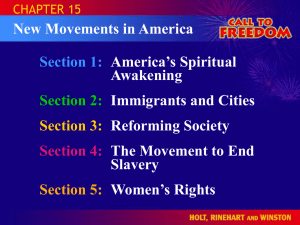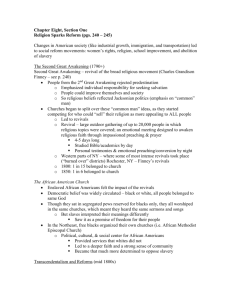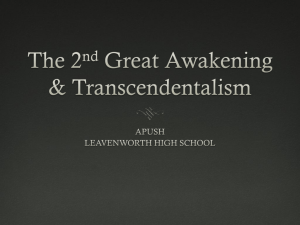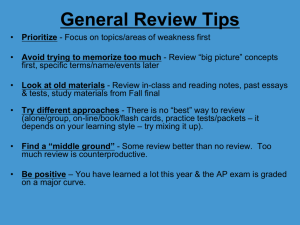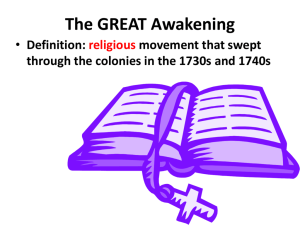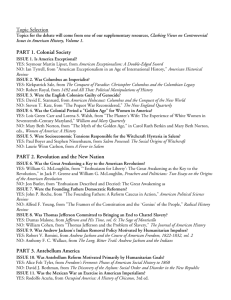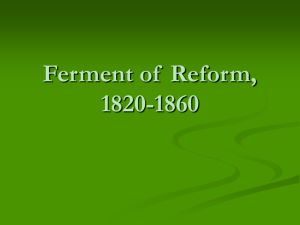Lecture Talking Points
advertisement
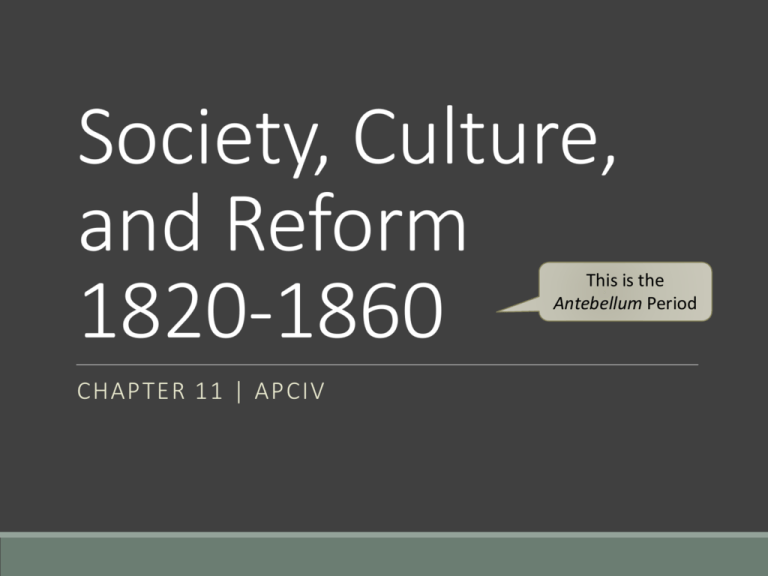
Society, Culture, and Reform 1820-1860 This is the Antebellum Period CHAPTER 11 | APCIV Religious Reform: The Second Great Awakening Partly in reaction to rationalism of the Enlightenment (human reasoning), religious revivals swept the country in the early 1800s Puritan ◦ Calvinist views of sin and predestination reacted against liberal religious movements ◦ This awakening will occur with educated individuals not convinced by Enlightened ideals ◦ President of Yale College in Connecticut motivated a generation to become evangelical preachers ◦ The notion of choosing to be saved: in an era of democratization, this was appealing ◦ Revivalism in New York c. 1823 in upstate New York (home to many New Englanders) ◦ Charles G. Finney preached to fear and damnation, but hope in hard work and faith ◦ This was alluring to a growing middle class with new opportunities for advancement ◦ Western New York as “burned-over district” due to all the “hell-and-brimstone” revivals ◦ Millennialism was a movement that supported the idea that the second coming (and end) was near ◦ Early Christianity as an apocalyptic Jewish sect, this idea was revived: 1844 as date of end; no end ◦ Joseph Smith (1830) of New York established the Church of Jesus Christ of Latter-Day Saints ◦ A controversial figure, he received over 100 “revelations” from God and traced a connection between Native Americans and the lost tribes of Israel ◦ His most controversial revelation was that of polygamy: “the most holy and important doctrine” ◦ He and his followers would head west in search of “New Zion” in light of persecution (polygamy) ◦ Joseph would be killed in Illinois by rioters, Brigham Young would lead the Mormons to Utah (Mexico) ◦ After Utah was admitted to the union, the US would pressure LDS to renounce polygamy; they did 1890 Culture: Ideas, the Arts, and Literature The Transcendentalists (Ralph Waldo Emerson and Henry David Thoreau) ◦ Writers that questioned religious doctrines and wealthy business classes In his book, Walden 1854 Thoreau ◦ Sought a more mystical and intuitive way to find one’s inner self through the essence of God in nature describes living in a cabin for two years ◦ Artistic expression is more important than material wealth: focused more on individualism outside of town, finding solace ◦ Emerson supported a nationalistic American culture separate from Europe: criticized slavery ◦ Thoreau sought personal truth through nature as well as nonviolent protest (US-Mex War 1846-8) ◦ Refused to pay taxes to protest: was thrown in jail for 1 day, but this was inspirational Communal Experiments (the idea of withdrawing from society for the utopia) ◦ Shakers (c. 6,000 members): kept men and women separate; obviously died out ◦ New Harmony (Indiana): attempted to establish a socialist utopia (end inequality) ◦ Failed due to debts and disagreements among members: individualism in America proved divisive (Fourier Phalanxes) ◦ Oneida Community: cooperative community where everything was shared (everything) ◦ Critics attacked the “free love” community but it, unlike the others, thrived socially and economically The Jacksonian Age gave rise to impulses of expression in art and literature ◦ Painting took to the ordinary: representations of typical American life ◦ Architecture took to Greek forms in light of a democratization of America ◦ Literature took a new, unique American tone as nationalism rose after the War of 1812 Reforming Society Temperance (in 1820 liquor consumption was 5 gallons per capita) ◦ Alcohol became the target of many social ills ◦ Responses were either complete abstinence or encouraging treatment ◦ Business classes joined on board: less drinking meant more production during work ◦ As businesses got involved, so did politics: Maine would prohibit production and sale of liquor 1851 ◦ 12 states followed before the Civil War: post war slavery became the issue but it would return 1870s Movement for Public Asylums (due to humanitarian efforts) ◦ Most criminals, emotionally disturbed persons, and more were confined and forgotten, even abused ◦ Efforts to better support these people rose: state-sponsored prisons, mental hospitals, and caretakers ◦ Dorothea Dix (a former school teacher) was horrified to see mentally ill persons incarcerated next to criminals: advocated for their well-being nationwide with great success (support for mentally ill) ◦ Schools for the blind and deaf rose, separate from emerging public schools Public Education (free public schools for students of all classes) ◦ Uneducated native-born and immigrant children were rapidly rising ◦ Compulsory attendance at a growing number of schools became the norm for many states ◦ Protestant schools focused on morals like hard work, punctuality, and sobriety ◦ Catholics, distrusting Protestants, established and sent their children to private Catholic schools ◦ The Second Great Awakening fueled the growth of many private colleges (demoninational) Day 2 CHAPTER 11 | APUSH Changes in Families and Roles for Women Industrialization redefined the roles of families and women like never before ◦ Industrialized society reduced the economic value of children ◦ Birth control helped reduce the size of families: 7.04 in 1800 to 5.42 in 1830 ◦ This freedom (from constantly raising kids) allowed women the freedom to get involved in society ◦ The Cult of Domesticity: traditional farm families had the father as moral leader ◦ As men took jobs outside the home, women rose to be “in charge” of the home most of the time ◦ Women would become increasingly vocal against slavery ◦ Seneca Falls Convention 1848 (Europe and the smashing of the Revolution of 1848) ◦ Leading feminists met in New York to rally support and proposed the “Declaration of Sentiments” ◦ Declared that “all men and women are created equal”: listed grievances against discrimination ◦ Susan B. Anthony (and others) would campaign for this, but would be overshadowed by slavery The Antislavery Movement Came in various forms ◦ American Colonization Society 1817 (ship freed blacks back to Africa) ◦ The United States would acquire Liberia, Africa and establish the city of Monrovia, encouraging free blacks to move there ◦ Between 1820-1860, 12,000 black Americans would relocate while the slave population increased by 2.5 million ◦ American antislavery society 1833 Like the growth of the Tea newspaper, Party via The Liberator ◦ 1831, William Lloyd Garrison began publishing an abolitionist radicalism ◦ Went as far as to demand the Constitution be burned, saying “no Union with slaveholders” ◦ Garrison’s radicalism would give rise to the Liberty Party with one platform in 1840 “free the slaves” ◦ Black Abolitionists (Frederick Douglass, Harriet Tubman, et cetera) ◦ The educated, free black Americans who would support the growing movement (even illegally: U RR) ◦ Violent Abolitionism (freedom at any cost) ◦ Nat Turner, 1831 Virginia, led a revolt against owners: 55 whites were killed ◦ Whites responded by killing hundreds of slaves brutally ◦ Fear of future revolt only increased hostility towards slaves Other things in American news c.1830 Not 1830 Protect our sailors! Issues with flogging sailors and attempts to stop it Eat more wheat! Dietary concern over poor nutrition Skin is sexy! Women were tired of wearing only long dresses He’s gonna be president! phrenology could predict character and abilities from bumps on the skull (pseudoscience) In all seriousness, the American Peace Society of 1828 protested the war with Mexico in 1846
